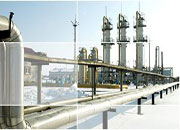The bloc will be hoping that the ban on all Russian oil from Europe will deal a hammer blow to the Russian economy, given it handed the Kremlin a staggering €48.5billion (£38billion) of crude oil in 2021, and €22.5billion (£19billion) of petroleum oils other than crude. But Russia still rakes in profits from partners in the East, and could see these soar further thanks to its planned network of oil and gas pipelines that link it to Asia.
The Power of Siberia is an active gas pipeline, operated by Kremlin-controlled energy giant Gazprom, that starts in Eastern Siberia, bringing natural gas from Russia’s far east to China.
It is a 2,200km-long onshore pipeline that was the first to ever bring Russian pipeline gas into China and it began operations in 2019.
And the two nations have struck a 30-year deal for Russia to supply more gas to China via the Power of Siberia 2.
This will involve the construction of a new 2,600km pipeline starting in the Bovanenkovo and Kharasavey gas fields in the Yamal region of Russia.
This could help tilt the balance away from Europe, which is Russia's largest customer by a mile, importing a staggering 200 billion cubic meters of gas every year, accounting for nearly 30 percent of the continent's supply.
Currently, China purchases about 38 billion cubic metres annually, but the Power of Siberia 2 could double those exports.
This is not the only pipeline linking China to Russia.
And China is not the only Asian partner that could soften the blow as Europe slashes ties.
The Sakhalin–Khabarovsk–Vladivostok pipeline, also owned by Gazprom, is set to carry Russian gas to East Asian countries.
First opened back in 2011, the 1,822km system will bring gas from Russia’s Far East China and Japan and there is a planned link to South Korea.
And gas is not the only Russian energy source flooding into East Asia.
The Eastern Siberia–Pacific Ocean Oil Pipeline brings Russia’s crude oil to Japan, China, and South Korea.
It is built and operated by Russian pipeline company Transneft and is a staggering 4,85km-long system.
Another oil pipeline, the Baku–Novorossiysk, is a 1,330km system travelling from Russia through to Azerbaijan, sending the equivalent of 105,000 barrels per day.
In 2015, Russia struck a deal with Pakistan to build a 1,100km long pipeline to deliver Russia’s imported Liquified Natural Gas (LNG) from Karachi to plants in the northeastern province of Punjab.
The planned annual capacity is set to tally in at 12.4 billion cubic metres (bcm), with the possibility to boost this to 16bcm.
In March Pakistani Prime Minister Imran Khan announced that he struck a deal with Putin to import more of Russia’s natural gas after having “great discussions” with the Russian leader.
Meanwhile, India is the world’s third-largest importer of oil, and has been stepping up its purchase of Russia's crude oil supply in recent months.
Since Russia’s invasion of Ukraine, India has purchased more crude oil from Russia in the past two months than it did in all of 2021.
Nirmala Sitharaman, India’s FInance minister stated that New Delhi would continue to buy crude oil from Russia at a discount while prices in the rest of the world skyrocket.
She said: “I would put my country’s interest first, I would put my energy security first. If the fuel is available at a discount, why shouldn’t I buy it?”
By Jacob Paul, Daily Express


